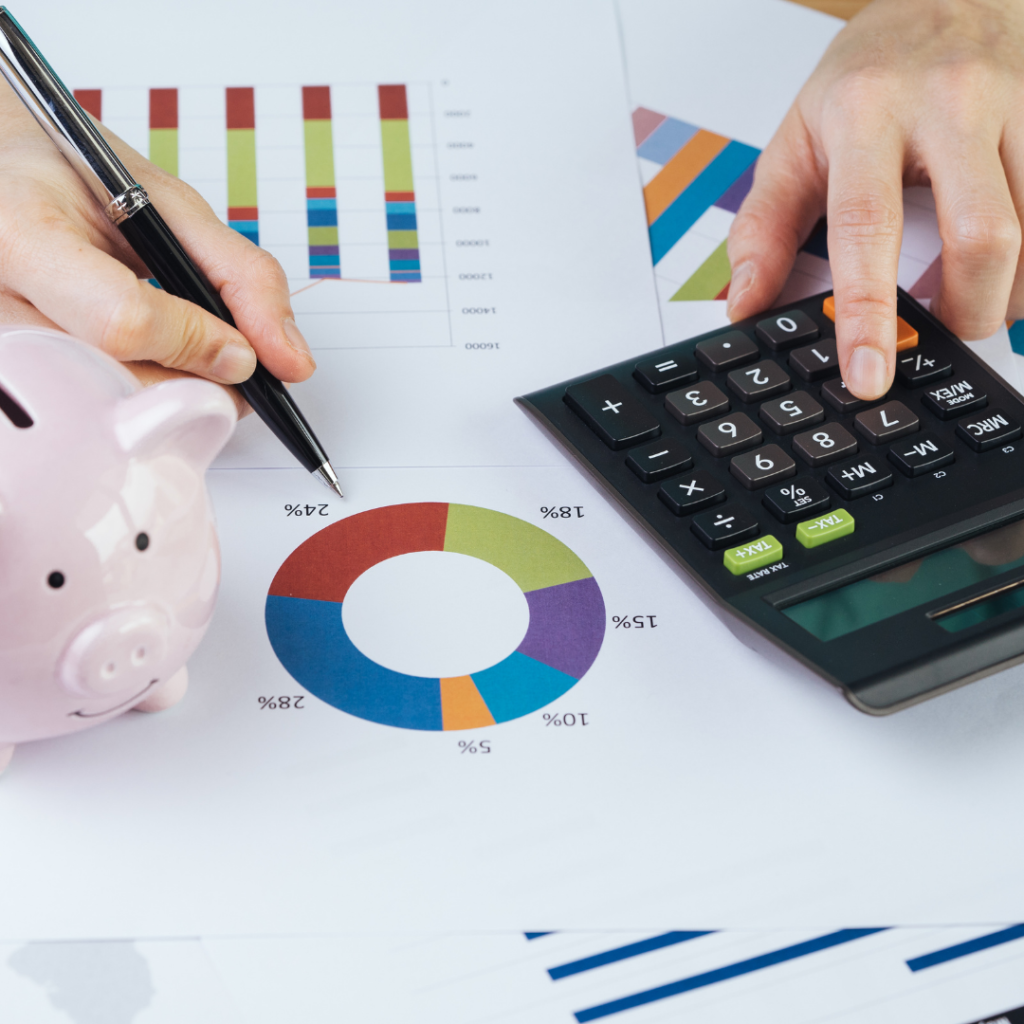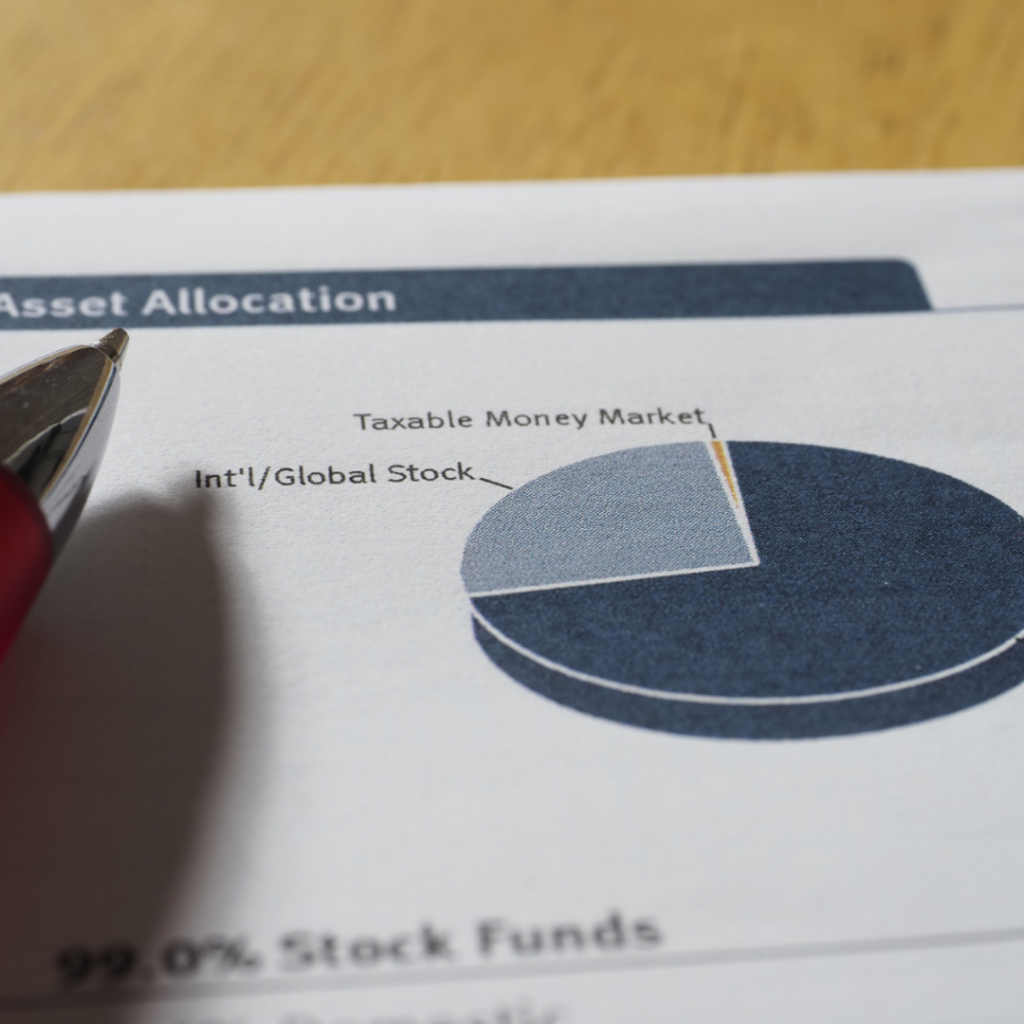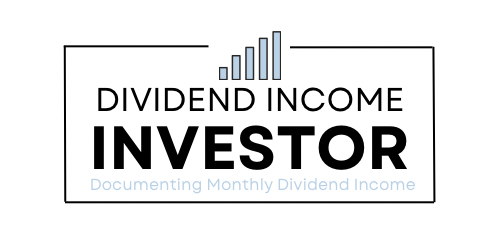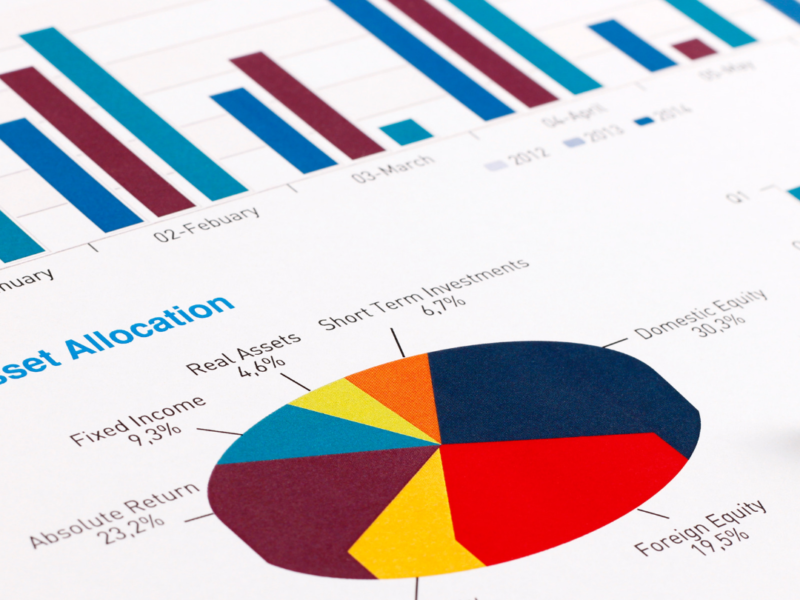Portfolio allocation strategy – My target portfolio is 80% dividend growth stocks, 10% USD growth stocks, 5% S&P 500, 3% REITs, 1% Bitcoin, and 1% cash. I am not a licensed investment advisor and this article is not investment advice.
As your wealth grows over time, it’s important to have a portfolio allocation strategy in place to manage it.
Basically, you need to have a plan for what assets you want to own and what percentage of your portfolio you want to allocate to each asset class.
In this article, I will share my personal portfolio allocation strategy to show you a breakdown of how I divide up my financial assets.
As always on this blog, I am not offering investment advice. I am sharing what I am doing with investing. This may not be the best portfolio allocation strategy for you.
Let’s dive into how I’m managing my financial assets.

Portfolio Allocation Strategy Goal
The goal of my investment strategy is to build a portfolio of assets that provides stability, a steady stream of growing dividend income, and to provide a reasonable amount of growth that is competitive with the S&P 500.
Ideally, my allocation to dividend growth stocks, growth stocks, and Bitcoin will lead to outpacing the S&P 500.
Meanwhile, the quality of my dividend growth stocks and the cash position I hold adds stability.
In short, my goal is to create a portfolio that competes with the S&P 500 returns. Further, it pays a higher dividend than the S&P 500 and the dividend income is more predictable.
Portfolio Allocation Strategy (Turn Over And Changing Strategies)
Most investors aim adjust their portfolio based on their age and how close they are to retirement.
For example, they will move a percentage of their portfolio to bonds for stability as they get closer to retirement.
In my case, my portfolio allocation strategy is to never change my strategy.
Unless interest rates drastically change, I do not anticipate that I would alter my investment strategy, even when I retire. I always want a reasonable amount of growth and dividend income. So, I will always hold dividend stocks.
Furthermore, I am comfortable with volatility. I prefer not to own bonds at all even if it balances out volatility.
Simply put, I am trying to create a life-long investment strategy that never changes.
Of course, if I can earn 8% on a savings account, I would likely start allocating more money there because it’s risk free.
So my portfolio allocation strategy could change slightly at some point. But the changes will only be slight.
Let’s dive into the allocation.
Canadian Dividend Stock & U.S. Growth Stock Strategy
Over time, my investment strategy has evolved into a Canadian dividend and U.S. Growth stock strategy.
Ultimately, this is due to tax consequences and conversation rates of CAD to USD.
Simply put, a dividend income strategy does not work as well in an RRSP. You get taxed on withdrawals and an RRSP has to eventually become a RRIF. So, there are forced withdrawals of specific amounts.
As such, my investment strategy evolved to hold U.S. growth stocks and the S&P 500 in my RRSP.
As of right now, my savvy RRSP withdraw plan is to retire early and deplete my RRSP before it is forced to become a RRIF. So, my strategy is to get as much growth as possible in it over the next 10 to 15 years before beginning to withdraw.
Once I start to withdraw, I will live off my RRSP while continuing to grow my dividend income in my TFSA and Non-Reg accounts.
TFSA & RRSP
In simple terms, my current strategy is to hold Canadian stocks in my TFSA and USD stocks in my RRSP.
A more detailed overview of it is that I hold Canadian dividend stocks plus Shopify in my TFSA. This is where I will focus on my dividend income investing strategy.
As for my RRSP, it will be used to hold U.S. growth stocks and an S&P 500 index fund.
Of course, some USD dividend stocks are held in my RRSP, including Apple, Starbucks, AbbVie, and more.

Portfolio Allocation Strategy
Below is a more detailed breakdown of what percentage of my portfolio is allocated to specific assets.
80% Dividend Stocks
I am a value investor that specializes in dividend stocks with strong brands.
As such, the majority of my wealth will always be invested in dividend stocks.
To be more specific, mostly dividend growth stocks. I prefer to own dividend stocks that can safely raise their dividends annually. I look for companies with low payout ratios and a proven ability to increase earnings.
Furthermore, I thoroughly enjoy dividend investing. I enjoy documenting the journey and tracking the progress in my dividend income updates.
Simply put, dividend investing is the investment strategy that keeps me invested.
I will continue to be a dividend income investor because of its predictability and reliability.
With dividend investing, I am reasonably able to predict how much dividend income I will earn in 10, 15, 0r 20 years.
I honestly question if an 80% is a high enough allocation.
10% USD Growth Stocks
At the very most, I will put 10% of my financial assets in USD growth stocks.
By USD growth stocks, I am referring to USD stocks that do not pay a dividend. I am referring to companies that early still in the early stages of establishing themselves, and companies that are rapidly growing revenue.
Frankly, I am referring to more speculative stocks that could generate extremely high returns.
As of right now, one of my favourite long-term growth stocks is Palantir. Otherwise, I am continuing to investing in fractional shares of Shopify, which is not a USD company, but it is still a growth stock.
5% S&P 500
Beginning in 2022, I plan to allocate a 5% position to VSP in my RRSP.
This is to align with my plan to grow my RRSP as fast as possible and be as tax efficient as possible. Also, it’s because I plan to deplete my RRSP before it becomes a RRIF.
Basically, I will invest in VSP when I don’t have growth stocks to buy or on market pull backs. I will maintain a 5% position in the S&P 500 to grow my RRSP quickly.
3% REITs
In addition to dividend stocks, I hold REITs (real estate investment trust) for income.
However, I maintain a much lower allocation to REITs than I do to quality dividend stocks.
This is because REITs don’t usually offer dividend raises or capital appreciation like dividend stocks do.
On the other hand, REITs are an excellent way to boost monthly income. They typically pay distributions monthly and offer high yields. In turn, you can compound wealth monthly instead of quarterly.
Also worth noting, REITs are taxed differently than stocks. In most case, it’s best to hold REITs in registered accounts. And it’s important to make sure they are eligible for registered accounts. Some REITs are not.
1% Bitcoin
Even though I am quite bullish on Bitcoin, I am still capping my maximum allocation to it at 1%.
Basically, I view it as an alternative to holding gold. It’s a way to diversify my portfolio with another asset class that grows faster than inflation.
Part of me wants to go as high as 10% of my portfolio in Bitcoin. I want to call myself a Bitcoin maximalist. But the other part of me is skeptical about the speculative, fanatical side of it. I just don’t like how overly certain some of its promoters are.
Aside from the fanatical promoters of Bitcoin, I believe it’s a revolutionary technology and an alternative to holding gold. I will maintain a 1% position in Bitcoin.
1% Cash
Each time I get paid, I save 1% of my pay into a high interest savings account.
This is basically my 1% cash position.
Even though I am not a fan of holding cash, I maintain a 1% position as an insurance against my portfolio. It prevents me from having to sell stocks.
Further, it is there for emergencies as well and it adds another layer of stability to a portfolio.
But I wouldn’t hold much cash in a high inflation environment like we are in right now. So, I am setting the limit at 1% maximum.
What Happens If Growth Outgrows 10%
If it so happens that my 10% allocation to growth stocks doubles, this is a good problem to have.
Personally, I would be ok with being overweight in the growth sector if one of my growth stocks explodes.
I would temporarily avoid allocating more to growth stocks. I would just invest most of my savings into other assets until my portfolio is properly allocated again.

Portfolio Allocation Strategy — Final Thoughts
The only other asset that I failed to mention is a property.
At some point in the future, I expect property to be part of my portfolio and I will include it with my net worth.
But it will remain a separate category from my financial assets.
In conclusion, I am a dividend investor that focuses on Canadian dividend stocks and U.S. growth stocks. My target portfolio is 80% dividend growth stocks, 10% USD growth stocks, 5% S&P 500, 3% REITs, 1% Bitcoin, and 1% cash.
Similar Articles On Investing To Check Out
Projecting Dividend Income Over 10, 15, and 20 years
S&P 500: How To Buy It And Turn $10,000 Into $420,000
Is Buying Fractional Shares Worth It? 5 Undeniable Benefits
Best Growth Stocks: 4 Stocks That Could Make You Rich
Monthly Dividend REITs: 5 Reliable REITs That Pay Every Month
I am not a licensed investment or tax adviser. All opinions are my own. This post may contain advertisements by Monumetric. This post may also contain internal links, affiliate links to BizBudding, Amazon, Bluehost, and Questrade, links to trusted external sites, and links to RTC social media accounts.
Connect with RTC
Twitter: @Reversethecrush
Pinterest: @reversethecrushblog
Instagram: @reversethecrush_
Facebook: @reversethecrushblog
Email: graham@reversethecrush.com


 How To Start Dividend Investing With Little Money
How To Start Dividend Investing With Little Money
